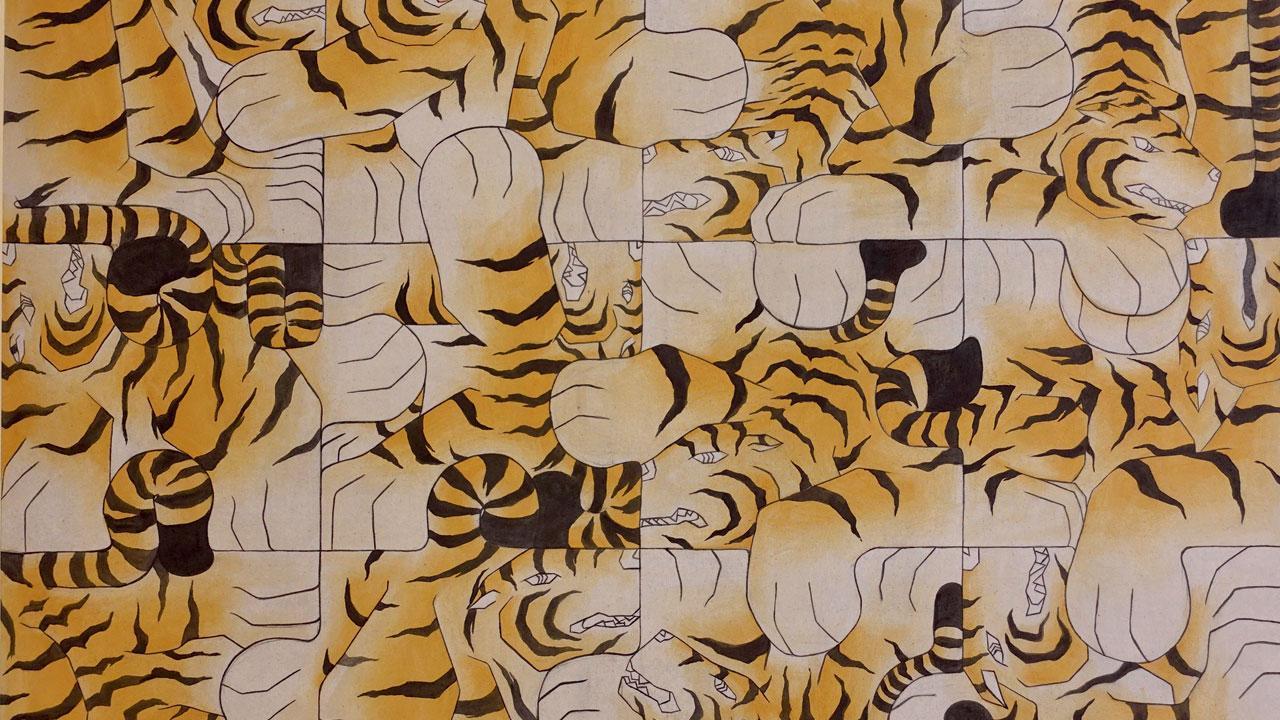Bhutanese painter Zimbiri’s ongoing display portrays the animal in abstractions

The artist’s piece titled Puzzle A
Even if we seek the impossible, we can never imagine a tiger — a symbol of ferocity — as a crane, a bird that embodies joy in Greek traditions. Of Horses and Cranes, an early piece by Bhutanese artist Zimbiri, depicts a tiger cutting through air on all fours, as a horse onlooker trots far behind. Pigs can fly, but can tigers? We look harder and find the tiger flap a pair of wide white wings. Zimbiri shares that her piece was an attempt to document history: “It was conceived during Bhutan’s first election. One party had a crane as its insignia, and the other had a horse. Art is at once wielding power and beauty. Even in countries with acute censorship, artistic creations relentlessly record events in time.” She adds that she wanted to participate in that legacy with her horse-crane art. The piece juts out as the crane and horse wear the same tiger skin.
Her first exhibition was also the first solo one by any woman in her homeland. After that, Zimbiri has continued to revisit the subject of the tiger. In the ongoing display at Delhi’s Nature Morte gallery, available for viewing online, she explores a tiger’s energy within box-like constrictions. But why the title, Imaginary Lines? Zimbiri explains, “The series, although along the lines of my usual theme, navigates borders that we befriend in a civil set-up. We are put into boxes; for instance, every child in a classroom represents a type or a box. That fragmented idea of being may not limit us, but these are questions I pose to myself. Since we create demarcations in the physical world, demarcations that aren’t tactile, I call these lines imaginary.”
 Zimbiri
Zimbiri
Puzzle A, one of the new art pieces, shows the tiger as a disintegrated whole. The pieces of the puzzle just won’t fit. Zimbiri premeditated the impact of pieces not falling into their projected positions.
Was painting tigers a conscious thought? She says the contemplative engagement was born of a culture she is deeply rooted in, but she was not aware of her fixation. “Tigers are an integral component of the Bhutanese cultural fabric. You see it in murals, on temple walls, in architecture, and building designs — it resides in me. Most of my work during college was a diversion from my roots. I didn’t want to use my culture as a mobility aid for art. Over time, I only realised that it defines me,” says the 30-year-old.
Her tradition swells in countless shapes as she colours with saa-tshen. Saa-tshen, or pigmented earth, when used on a hand-woven canvas (rhay-shing) can change colour. If an artwork is left incomplete, it can be difficult to match the shade of yellow or red later. The tigers in Imaginary Lines flaunt a typical flatness that almost gives away their temperaments. As they spread out onto a space and run in and out of boxes, we wonder if cats — patrons of self-love — float amidst sympathetic man-animal ties.
Till March 18
Log on to naturemorte.com
Free
 Subscribe today by clicking the link and stay updated with the latest news!" Click here!
Subscribe today by clicking the link and stay updated with the latest news!" Click here!










